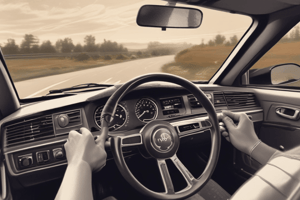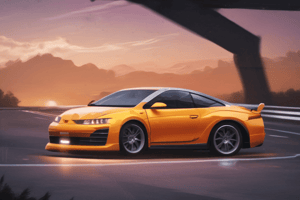Podcast
Questions and Answers
What is oversteering?
What is oversteering?
Turning the steering wheel too much, causing the vehicle to weave from side to side.
What is understeering?
What is understeering?
Not turning the steering wheel enough, which causes the vehicle to continue too far in one direction before correcting.
What are the steps for steering straight backward?
What are the steps for steering straight backward?
- Hold the brake and shift to reverse. 2. Turn your body to the right, looking back. 3. Left hand at the top of the wheel. 4. Release pressure on the brake to creep backward. 5. Move the wheel towards the desired direction. 6. Keep your foot on the brake.
What is the process for backing a stickshift vehicle?
What is the process for backing a stickshift vehicle?
What is the hand signal for a right turn?
What is the hand signal for a right turn?
What is the hand signal for a left turn?
What is the hand signal for a left turn?
What is the hand signal indicating slow or stop?
What is the hand signal indicating slow or stop?
List the steps for changing lanes to the left.
List the steps for changing lanes to the left.
Describe hand-over-hand steering.
Describe hand-over-hand steering.
What are the procedures for turning?
What are the procedures for turning?
What is a shared left turn lane?
What is a shared left turn lane?
What is a turnabout?
What is a turnabout?
What is involved in a three-point turnabout?
What is involved in a three-point turnabout?
What is a reference point in driving?
What is a reference point in driving?
What is the standard reference point?
What is the standard reference point?
What does a personal reference point mean?
What does a personal reference point mean?
What is angle parking?
What is angle parking?
What is perpendicular parking?
What is perpendicular parking?
What is parallel parking?
What is parallel parking?
What should you do when parking on hills?
What should you do when parking on hills?
What are the steps for uphill parking on a curb?
What are the steps for uphill parking on a curb?
What should you do when parking uphill or downhill where there is no curb?
What should you do when parking uphill or downhill where there is no curb?
What is the procedure for starting on a hill using automatic transmission?
What is the procedure for starting on a hill using automatic transmission?
Flashcards are hidden until you start studying
Study Notes
Steering Techniques
- Oversteer: Caused by turning the steering wheel too much; results in the vehicle weaving side to side.
- Understeer: Occurs when the steering wheel is not turned enough, leading the vehicle to drift off course before correction can be made.
Backward Maneuvering
- Steering Straight Backward: Involves holding the brake, turning the body, and steering in the desired direction while moving backward.
- Backing a Stickshift Vehicle: Requires pressing brake and clutch, shifting to reverse, and managing the clutch to control movement.
Hand Signals for Turns
- Right Turn Signal: Left arm/hand pointing up.
- Left Turn Signal: Left arm/hand extended straight out.
- Slow or Stop Signal: Left arm extended downward.
Lane Change Procedures
- Lane Change to the Left: Check traffic zones, signal, check blind spots, increase speed slightly, and adjust speed after changing lanes.
Steering Methods
- Hand Over Hand Steering: Involves pulling the wheel down with one hand while the other crosses over for more control.
- Push-Pull Steering: Push the wheel up with one hand and pull it down with the other for smooth steering.
Turning Procedures
- Turning Protocol: Position vehicle in the correct lane, signal early, check zones, slow down, and check blind spots before completing the turn.
- Shared Left Turn Lane: A center lane that allows midblock left turns into business areas.
Backing Techniques
- Backing Left and Right: Check traffic before backing and turn the wheel toward the desired direction while keeping both hands on the wheel.
Turnabout Maneuvers
- General Turnabout: A maneuver to turn your vehicle around.
- Midblock U Turn: Requires wide space and checking all zones before executing.
- Backing into a Driveway: Preferred when clear on the right side for safe reentry into traffic.
- Pulling into a Driveway: High-risk as it involves backing across multiple traffic lanes.
- Three Point Turnabout: High-risk in traffic; only to be used on dead-end streets or rural roads.
Reference Points in Driving
- Reference Point: A part of the vehicle viewed from the driver's seat that aids in positioning on the roadway.
- Standard Reference Point: Common reference points used by most drivers.
- Personal Reference Point: Customized version of standard reference points for individual vehicles.
Parking Techniques
- Angle Parking: Involves parking diagonally to the curb.
- Perpendicular Parking: Parking at a right angle to the curb.
- Parallel Parking: Parking parallel to the curb.
Parking on Hills
- Always turn front wheels away from the curb when parking uphill and towards the curb when downhill to prevent rolling.
- Uphill Parking on a Curb: Involves positioning your vehicle close to the curb, shifting to neutral to allow it to creep back, and then setting the parking brake.
- Parking Without a Curb: Always turn wheels to the right when parking on hills without a curb.
Starting on a Hill with Automatic Transmission
- Requires holding the foot brake, engaging the parking brake, accelerating until the engine catches, and then releasing the parking brake while continuing to accelerate.
Studying That Suits You
Use AI to generate personalized quizzes and flashcards to suit your learning preferences.



